Alfa Romeo Doesn’t Spare Theatrics for New Giulia
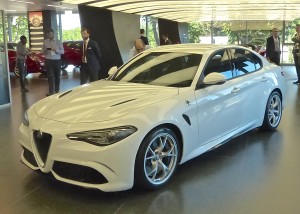
Alfa Romeo unveiled the new Giulia midsize sedan as the focal point of its return to competitiveness.
By John Gilbert
MILAN, Italy — When Italians decide to do something, they tend to do it wearing their emotions on their sleeves. Or at least their fenders. That unrestrained optimism accompanied the world introduction of the new Alfa Romeo Giulia, a sport-luxury sedan that is a perfect example of living up to the hyperbole accompanying that legendary Italian passion.
There is no argument about how important the new Giulia sedan is to “resurrect” Alfa Romeo, just as there is no way to overstate the importance a healthy Alfa Romeo can have for Fiat, and therefore Fiat-Chrysler Automotives, on the world automotive stage. As a midsize sedan, the Giulia is not shooting at Accord, Camry, Fusion, Malibu type sedans. It is aimed directly at the top German performance sedans, such as the BMW M3, the Mercedes AMGs and the Audi S4.
In order to run with, and ahead, of such luminary competitors, governing FCA built an entirely new platform and an entirely new 3-liter V6 with Ferrari engineering. While similar to a Ferrari designed engine used by Maserati in the Ghibli sedan, some media types assume that is the Giulia engine — a point Alfa officials refuted almost to the point of confrontation. We will believe that the Giulia V6 is all new.
Alfa built the mid-size sedan in almost total secrecy, engaging what it calls a “skunk-works” of devoted and single-minded engineers to design and build the car. That term dates back to World War II, when Alfa engineers wanted to hide their latest prize from the Fascist Italian government, and joined the secret Lockheed project to develop the F80 Shooting Star jet fighter that helped hasten the end of the war.
For the Giulia introduction, Alfa summoned several hundred automotive journalists from all over the world to come to Milano where the car shared the spotlight with the opening of the Alfa Romeo museum, with its display of hundreds of vehicles that trace the 105-year history of Alfa car-building.
In the museum’s auditorium, Alfa Romeo president Harald Hester started the show, followed by chief engineer Philippe Krief, and design chief Lorenzo Ramaciotti. When Ramaciotti talked about the passion that is an Italian hallmark, he mentioned how it is similar to Italian classical music, such as that performed by brilliant tenor Andrea Bocelli. At that moment, Bocelli was escorted onstage. He read a love poem he had written, and then he sang “Nessun Dorma,” and when he hit the operatic crescendo, a stunning red Giulia sedan was driven out on the stage behind him.
Theatric overkill? More like colorful Italian tradition.
Sergio Marchione, chairman of Fiat Chrysler Auto, was next at the podium. “Over two years, we developed a quintessential example of all that made Alfa Romeo a car coveted by passionate drivers the world over,” said Marchione. With 510 horsepower and 0-100 [kilometers] acceleration in 3.9 seconds, we have created a car that has no need to be compared to others.
“This is one of the most impressive cars I’ve ever been associated with,” Marchione added, noting that the “skunks” at the skunk-works were able to think outside the box, starting with a clean sheet of paper, and “unimprisoned by barriers we sometimes build for ourselves.”
It’s easy to see why Marchione is the head man at Fiat Chrysler Auto, which includes all things Fiat, Alfa, Ferrari, Maserati, Lancia, Chrysler, Dodge, Ram and Jeep. Fiat returned to the U.S. only after the parent company took over the faltering Chrysler LLC, and is just now reintroducing Alfa Romeo to the U.S. Those old enough to remember might best recall Alfa for the sleek little roadster Dustin Hoffman drove to try to interrupt Katherine Ross’s wedding in the timeless movie, “The Graduate.”

Familiar triangular Alfa center point on the grille links thoroughly modern Giulia with historic past.
While Alfa has slipped in popularity, almost to extinction, its heritage has remained strong, and new models like the 4C sports car and the Giulia are just the beginning of the planned resurrection.
“Alfa Romeo has a legendary place in automotives,” Marchione added. “It has so many admirers throughout the world, but it has not been reflected in commercial success. Other than Ferrari, and maybe Jeep, I don’t know of any other car capable of expanding so much of its core tradition.”
We couldn’t drive the cars, yet, so we had to be satisfied with their stunning appearance, and the deft descriptions by Alfa executives. Hester opened the program describing the uniqueness of the brand and said, “Making and creating are not the same thing. We wanted to create something different, to put the driver back at center stage. An Alfa Romeo is never just a car, just a machine. It is beyond the scope of being just a machine.”
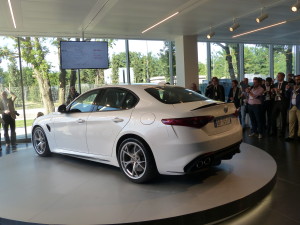
All the sleek lines reach a harmonious conclusion at the rear of the Giulia, which takes aim at the BMW M3.
Chief engineer Krief explained the rear-wheel or all-wheel platform, housing the all-aluminum 6-cylinder bi-turbo engine, featuring Ferrari technology and engineering skill. “Turbo lag is nonexistent, and it has excellent torque at all RPMs,” Krief said. “It also has cylinder deactivation, and Alfa invented that technology in the early-‘80s. We then worked to get the engine to sing, as it should. The Giulia has 50-50 weight distribution, and our level of driving enjoyment depends on the suspension, which has ‘Alfa Link’ at the rear for maximum movement control, and double wishbone in front with a new steering system that is the most direct on the market. It has carbon ceramic brakes, and the best torsional rigidity in its class.
“Electronics are used to increase performance, not cover up shortcomings, and it has real torque-vectoring, with a double clutch system to separate the torque going to each wheel. Rear-wheel drive can be a problem on slippery roads, which is why we also offer all-wheel drive. The response is quick and it has the lowest coefficient of drag in the segment, with a front aero splitter, so it is safe to drive, even at very high speed.”
The interior is filled with classic features, real wood and real leather surrounding everything, including a console that has two round knobs. The left knob is smaller, thankfully, and it directs the driver to N, A, D, and Race. The N is for normal operation, the A is for Advanced, the D for Dynamic — which is more advanced — and the Race is for a full-out race-smooth performance setting. That control governs the direct-sequential gearbox as well as the suspension firmness and the amount of effort necessary to send the Giulia down the road.
Design chief Ramaciotti said the organically shaped car “challenges time, passion and space with its tension — part of the culture at Alfa Romeo. The short overhangs, long wheelbase, compact body, and simplicity” is the feature of the exterior, with its Alfa-emblem nose and elegant silhouette. Inside, he said, “all you see is leather, wood and carbon fiber. The whole package is a coveted object of desire, not an ornament.”
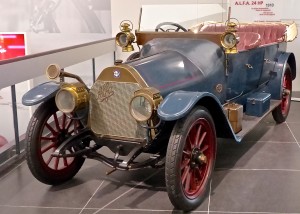
Alfa takes great pride in building passionate cars, starting with the first one, this 1910 museum piece.
Marchione said FCA plans a rapid expansion for Alfa, which reportedly includes a crossover SUV/van, a larger sedan, and enough other models to sell 400,000 vehicles worldwide by 2018. The museum, filled with classic vehicles dating from the 1910 model and on up to the current era, including 1937 and ’38 Giulia and Giulietta models, and a Gran Primo race car that had two Ferrari V12 engines — one in front and one behind the cockpit.
“It will be easy to rediscover Alfa Romeo’s identity,” said Marchione, “because Alfa has lived through, and often written, so much history.”



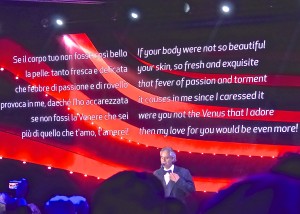
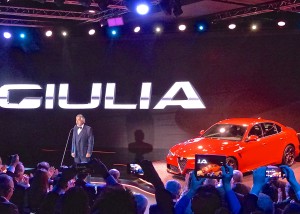
 John Gilbert is a lifetime Minnesotan and career journalist, specializing in cars and sports during and since spending 30 years at the Minneapolis Tribune, now the Star Tribune. More recently, he has continued translating the high-tech world of autos and sharing his passionate insights as a freelance writer/photographer/broadcaster. A member of the prestigious North American Car and Truck of the Year jury since 1993. John can be heard Monday-Friday from 9-11am on 610 KDAL(www.kdal610.com) on the "John Gilbert Show," and writes a column in the Duluth Reader.
John Gilbert is a lifetime Minnesotan and career journalist, specializing in cars and sports during and since spending 30 years at the Minneapolis Tribune, now the Star Tribune. More recently, he has continued translating the high-tech world of autos and sharing his passionate insights as a freelance writer/photographer/broadcaster. A member of the prestigious North American Car and Truck of the Year jury since 1993. John can be heard Monday-Friday from 9-11am on 610 KDAL(www.kdal610.com) on the "John Gilbert Show," and writes a column in the Duluth Reader.